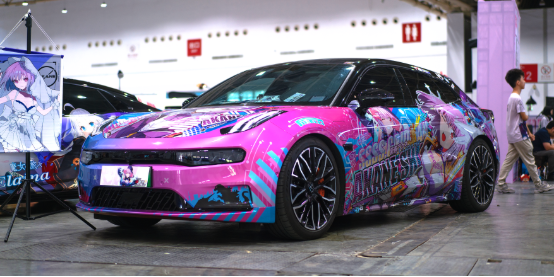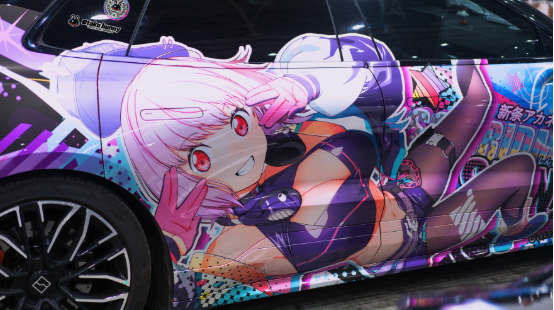In the world of custom car culture, trends come and go, but few have blended personal passion with creative expression quite like the Itasha wrap movement. What began as a niche subculture in Japan has transformed into a global phenomenon, uniting anime enthusiasts and automotive customization experts alike.
If you’re new to the term, Itasha (痛車) roughly translates to “painful car” in Japanese—a tongue-in-cheek reference to how gaudy or embarrassing these cars might appear to non-fans. But to those in the know, Itasha is a powerful form of fan expression that puts anime characters front and center—often in stunning, full-vehicle vinyl wraps that turn everyday vehicles into moving pieces of otaku art.
What Is an Itasha Wrap?
An Itasha wrap is a vinyl car wrap featuring characters, logos, or themes from anime, manga, video games, or other elements of Japanese pop culture. The designs are typically vivid, detailed, and highly stylized, often covering the entire vehicle from hood to trunk, and sometimes even including the windows and interior panels.
While stickers and decals were more common in the early days, the evolution of large-format printing and high-quality vinyl materials has allowed for more sophisticated full wraps that maintain both style and durability.
These wraps aren’t just for show—they often reflect the owner’s deep connection to a particular series or character. Much like cosplay, Itasha wraps are a way to represent a part of one’s identity in public. When done well, they balance artistry, fandom, and automotive flair.
Origins and Cultural Background
The Itasha trend began in the early 2000s in Japan, especially in Akihabara and Osaka—hotspots for anime culture. Originally, fans would decorate their vehicles with stickers and hand-drawn decals, often of moe (cute) anime characters. Over time, as wrapping technology improved, enthusiasts began creating large-scale graphics to cover their vehicles entirely.
Events like the Itasha Tengoku (Itasha Heaven) and Comiket car meet-ups gave fans a platform to showcase their creations. With Japan’s rich tuning culture already in place, it wasn’t long before this aesthetic customization became a full-fledged subgenre.
By the mid-2010s, Itasha had spread internationally, showing up at anime conventions, car shows, and cosplay events in North America, Europe, Southeast Asia, and Latin America. Thanks to social media and platforms like Instagram, Itasha builds now reach a global audience.
Designing an Itasha Wrap: Art Meets Engineering
Creating a standout Itasha wrap is no small task. It requires collaboration between a designer familiar with both anime aesthetics and wrap layout, a car owner with a vision, and a skilled wrap installer capable of turning that vision into reality.
Here’s a breakdown of the process:
- Conceptualization and Character Selection
Most Itasha owners begin with a clear idea: a favorite anime, manga, or game character they want to represent. This could be a solo character or an ensemble design from a specific title.
Popular characters include Hatsune Miku, Rem from Re:Zero, characters from Fate/stay night, Genshin Impact, Evangelion, and many others. The choice often reflects not just personal taste, but also how the character’s personality aligns with the car owner’s identity or lifestyle.
- Design Layout and File Preparation
Once the concept is set, designers map the car’s make and model to determine how the artwork will flow across panels. Unlike a poster or digital artwork, a car has contours, gaps, trim pieces, and 3D elements that must be accounted for.
Designers use vector graphics and high-resolution images (usually 300 DPI or higher) to ensure crisp print quality. Many Itasha wraps incorporate Japanese typography, color gradients, and subtle background patterns to give the wrap depth and dynamic movement.
- Material Selection and Printing
High-quality vinyl films from brands like 3M, Avery Dennison, or KPMF are often used. The film must be durable enough to handle UV exposure, road debris, and washing, while also flexible enough to wrap complex curves.
Eco-solvent or latex ink printers output the final designs, and the print is laminated to protect the artwork.
- Installation
Installation is as much an art as a science. Wrap installers must align the artwork precisely across panels while avoiding bubbles, wrinkles, and overstretching.
Since many anime wraps are intricate, wrap artists often do dry fits and panel-by-panel installations to maintain image fidelity. The process can take anywhere from one to five days depending on vehicle size and complexity.
Why the Itasha Wrap Craze Keeps Growing
Several factors have fueled the continued growth of Itasha worldwide:
- Crossover Appeal Between Car Culture and Anime Fandom
At its core, an Itasha wrap is about pride—pride in a fandom and in a vehicle. This crossover makes car shows and anime conventions ideal places for Itasha builds, creating communities where both gearheads and otakus find common ground.
- Customization and Personal Expression
No two Itasha builds are alike. This makes it one of the most personal forms of vehicle customization. Whether it’s a full wrap or selective panels, owners get to show off their favorite character in a completely unique way.
- Increased Accessibility of Wrap Technology
As vinyl wrap technology becomes more affordable and widespread, more fans can participate. Custom design services and online stores offer ready-to-use templates, and with a bit of skill, even DIY installation is possible for smaller vehicles or motorcycles.
- Global Community and Events
From Anime Expo in Los Angeles to Tokyo Auto Salon in Japan, and even pop-up meets across Europe, Itasha communities now organize regular car shows and online meetups. Platforms like Reddit, Instagram, and Discord help these builders connect, share designs, and collaborate on new projects.
Popular Cars Used for Itasha Wraps
While almost any vehicle can be transformed with an Itasha wrap, some models are especially popular due to their availability, panel shapes, and cultural relevance:
Mazda RX-7 / RX-8 – JDM legends that match the Japanese aesthetic.
Toyota 86 / Subaru BRZ – Sleek, sporty, and affordable to wrap.
Nissan Silvia S13/S14/S15 – A drift staple, often seen in both tuner and anime spaces.
Honda Civic / Integra – Accessible and widely modified platforms.
Lexus IS / Toyota Chaser – VIP-style builds often pair well with more elegant anime themes.
Motorcycles and scooters – Ideal for smaller, affordable entry points into the hobby.
Even American and European cars like the Dodge Charger, BMW 3 Series, or Volkswagen Golf GTI have entered the Itasha scene, showing the style knows no boundaries.
Challenges and Considerations
Despite its appeal, going all-in on an Itasha wrap comes with unique challenges:
Resale value – While wraps are removable, some buyers may hesitate at the sight of a fully anime-themed car.
Perception – Owners may face judgment or confusion from the general public unfamiliar with anime or otaku culture.
Copyright issues – Most Itasha wraps use copyrighted characters. While tolerated at fan events, public use (especially for commercial purposes) should be mindful of potential IP concerns.
Still, for most enthusiasts, the joy of self-expression far outweighs these hurdles.
Future of Itasha: Digital, Interactive, and AI-Driven?
As digital design tools become more powerful, we may see the next generation of Itasha wrap designs incorporate AI-generated art, AR/VR elements, or even reactive materials that shift colors or patterns.
Wrap studios and artists are already experimenting with layered finishes like holographic, glow-in-the-dark, or color-shifting vinyls to give Itasha builds more depth and interactivity.
The use of apps to preview wrap designs in real-time before printing is also growing, helping car owners make more informed aesthetic decisions.
Final Thoughts
The Itasha wrap is more than just a flashy design trend—it’s a powerful expression of personal identity, creativity, and fandom that blends the technical world of automotive customization with the emotional world of anime culture.
Whether you’re a seasoned car builder, a first-time wrap customer, or a die-hard anime fan, the Itasha scene has room for you. It represents a space where passion meets craftsmanship, and where rolling art continues to evolve with each generation of fans.






























